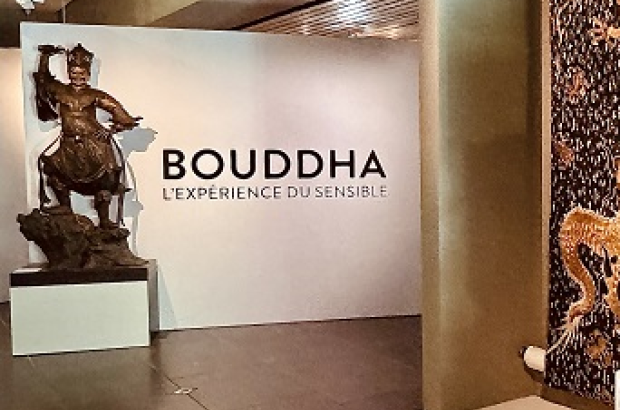- Daily & Weekly newsletters
- Buy & download The Bulletin
- Comment on our articles
Sensing the Buddha: Mariemont’s new exhibition is a sensory immersion in the source of art and contemplation
While showcasing its outstanding collection of Asian treasures, Mariemont Museum offers visitors a unique and immersive experience that fuses history, art and the senses.
Sensing the Buddha is not only a fascinating exploration of the art and iconography of the religion and tradition, it invites contemplation and a deeper understanding of Buddhist practices.
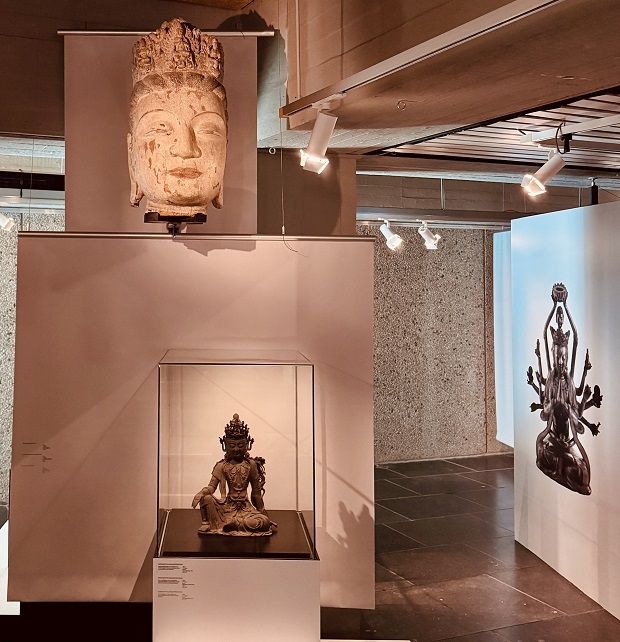
Around 100 works on display originate from the museum’s own collection; rare artefacts that have not been seen in public for almost 65 years, including 23 pieces specially restored for the occasion. They are joined by dazzling thangkas - painted scrolls - and paintings loaned by the Royal Museums of Art and History (RMAH) in Brussels.
Mariemont collaborated with the University of Ghent in its scientific research as well as Buddhist temples across Belgium. Combined with a bright and modern scenography boasting interactive elements to engage the emotions, it is designed to appeal to a wide audience, from families and people familiar with the practice to individuals in search of a reflective moment.

Greeting visitors on the ground floor of the museum is one of the museum’s heritage treasures. Previously located in the surrounding park, the bronze Avalokiteshvara statue is a multi-armed monument. It was thought to originate from Japan around 1910, but new research revealed that it was an almost unique original work, dating from the Chinese Ming dynasty in the last quarter of the 16th century. A digital information stand with 3D imaging of the statues outlines the meticulous study behind the discovery.
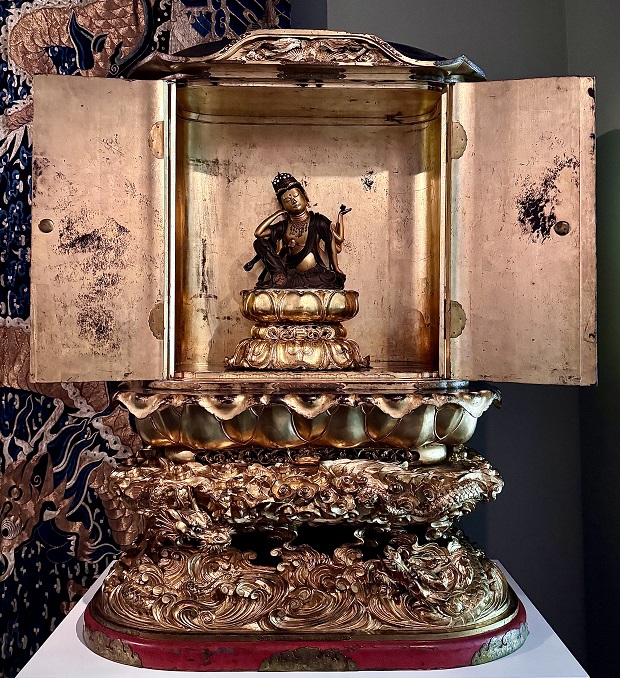
At the entrance to the exhibition stands an exquisite 19th century Japanese buddha, its diminutive size offset by the opulence of its ornate gold-lacquered surroundings. Divided into three sections, the exhibition presents the historical Buddha and the main practices and traditions of Buddhism, the multitude of representations, and finally the Buddhist community, including ceremonial and ritual objects.
Around one third of the works originate from China, one third from Japan and the remainder from India, Myanmar, Thailand, Tibet and Nepal, dating from between the 14th and 20th centuries. This geographical diversity is one reason for the sheer variety of objects on display, fabricated from bronze, golden brass, plaster, lapis lazuli, wood, ivory and ceramic.

Beyond the iconic image of a seated Buddha in a lotus position, there are multiple less-familiar versions, from simple to elaborate, crowned, reclining and child-like figures. A diagram explains the three different marks of Laksanas, or existence, along with the identifiable physical marks of Buddha and codified postures.
The lesser known bodhisattvas are a highly diverse incarnation of figures on the path towards enlightenment. They include 33 representations of the highly revered Avalokitesvara, who sacrifices his own spirituality to help others. The multiple arms symbolise his ability to come to the aid of numerous beings, while the presence of several heads shows his ability to understand their different needs.
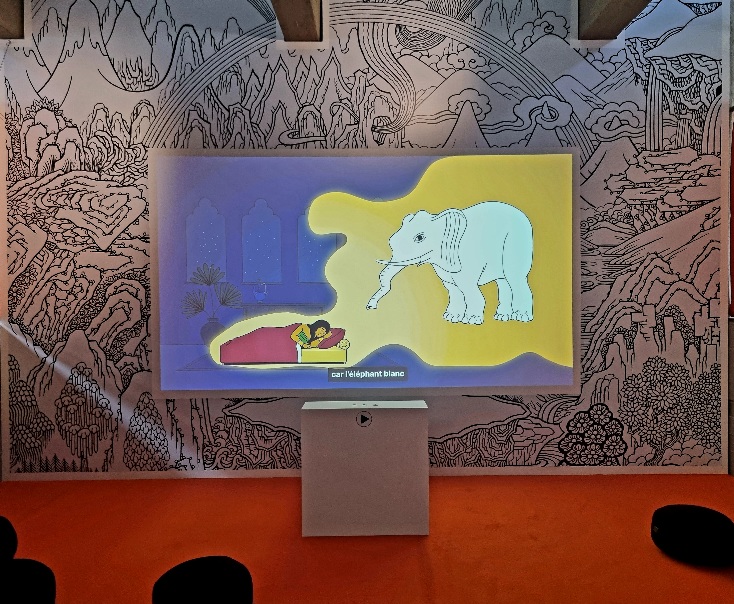
Surrounding the collection are inviting spaces housing installations involving the senses of sight, sound and touch. An appealing animation – accessible for all ages – traces the history of the founder of Buddhism in India, now modern-day Nepal. Elsewhere, you can create their own origami lotus flower or try your hand at calligraphy; both enhanced by digital installations.
A sound installation provides six testimonies from differing individuals who practice Buddhism in centres around Belgium as well as university professors. They are available in French, Dutch and English, as are the audio-guides recommended to accompany visitors throughout the tour.

In a curtained-off area, seven thangkas dazzle in the darkness, joined by objects such as a stupa and prayer wheel. Forming part of the ritual of meditation, the masterpiece scrolls originate from the RMAH’s Léon Verbert collection.
A final space completes the Buddhist community theme, offering a personal moment to pause and absorb the atmosphere of the Zen-like temple containing various ritual accompaniments.
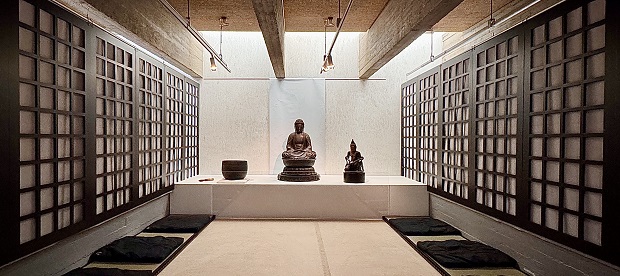
In the current world of continual digital connectivity, the exhibition not only delves into Buddhist practice through the prism of its heritage collection, it serves as a meditative experience. This can be extended in a mindfulness trail in the landscaped park and an outdoor photo exhibition of some 50 images of temples in Belgium by Andy Simon.
For Lyce Jankowski, co-curator with Lara Bauden, the exhibition’s originality lies in its participative dimension and transmission of knowledge about Buddhist communities. “It also differs in its approach via the senses, which reflects the museum’s mission.” She continues: “People are no longer capable of concentrating, so we didn’t want too many videos or technology, we wanted to return to a relationship with the original work that is personal and direct.”
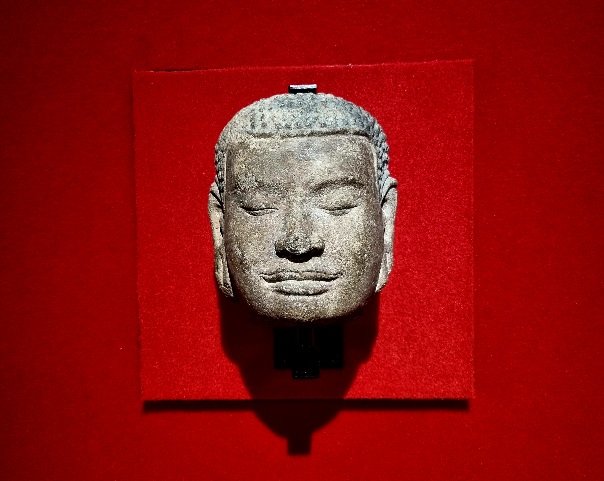
Long history of Buddhist art at Mariemont
The ongoing popular fascination around Buddhist iconography actually dates from the beginning of the 19th century. The founder of Mariemont, wealthy industrialist and politician Raul Warocqué (1870-1917), was an intrepid collector of masterpieces of classical antiquity. He amassed rare frescoes from Pompeii, Greek and Roman statues, as well as fine Chinese and Japanese works.
His Buddhist acquisitions from antique dealers in Brussels enriched his existing collections and fulfilled his interest in comparative religion. Upon Warocqué’s death, the estate was bequeathed to the state on condition that it was freely accessible to the public. Although a fire destroyed the chateau in 1960, the extensive collections survived relatively unscathed. A new museum was built in the 1970s, a modernist structure that lies in the vast parkland. It also contains artworks, including a fine outdoor Japanese section housing a monumental seated Japanese Buddha.

Much of the Buddhist art lay hidden away on shelves for decades in the museum’s reserves. When preparing exhibits for the show, Jankowski, an East Asia specialist and art historian, came across one work that she initially deemed too ugly and unsuitable. “After taking it out and studying it, we began to understand it and now I find it beautiful. You can see the remaining traces of gold leaf on its back and I realised that the artisan’s work was of a very high quality, especially in the face and the smile.”
Dating from the 16th or 17th century, from a period that did not produce “noble art”, it had long been dismissed as unworthy of attention, says Jankowski. “I find it touching that it was denigrated, while in fact it is magnificent”.
Does it show how good a collector Warocqué was? “In the museum, we’re accustomed to saying that he had great taste for the Greek-Roman period but that for China, he bought rather quickly from dealers, not benefitting from advisors as there was no curators for Asia at the royal museum in Brussels. But Warocqué bought well; we now realise that there are some impressive works among his acquisitions.”
Admission is free to the domain of Mariemont, the museum and its permanent collections. Temporary exhibitions such as Sensing the Buddha are priced at €8 for adults; €4 for 19-26 years; children free.
Sensing the Buddha
Until 20 April
Royal Domain of Mariemont
Chaussée de Morlanwelz 100
Morlanwelz
Hainaut province
Photos: ©Musée Royal de Mariemont; ©ImageStudio Musées royaux d’Art et d’Histoire, Bruxelles












